Scroll Helmets
Joe Robinson
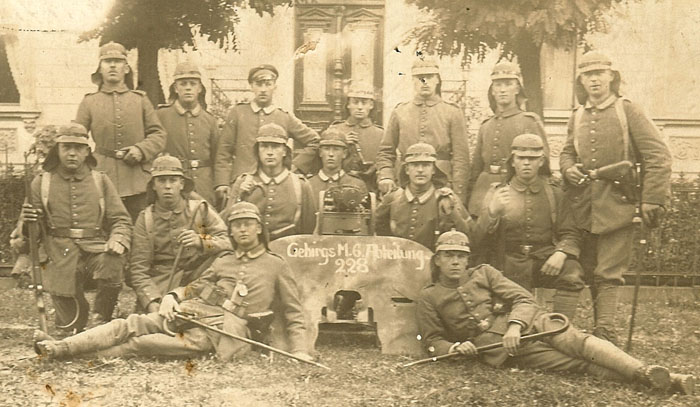
Several
years ago a friend of mine named Martin asked a series of simple
questions concerning a filz helmet he had bought that had a scroll
Wappen on it. My opinion flipped back and forth and I really do
not think I did Martin any great service. However, it started me
off on a search for "truth" concerning the scroll helmets. I have
yet to figure it all out but thought I would put some thoughts
down. My paltry efforts are all due to Martin and I thank him.
There
is very little information on these helmets and very few
pictures. As one of the benefits of earlier versions of this
article more pictures have come out of the woodwork and collections .
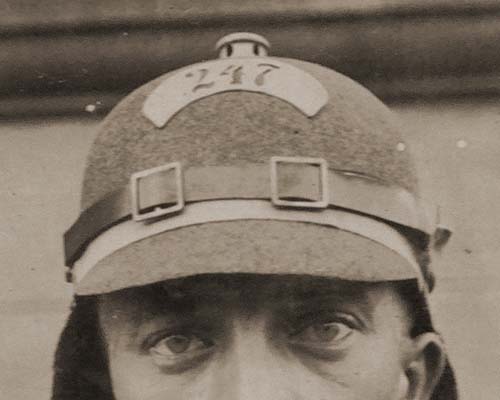 i
i
On
the eighth of December 1915 the Prussian War Minister authorized the
use of an experimental helmet for use with some troops earmarked for
Serbia.ii
Instead of having an eagle for Prussia as a helmet Wappen these helmets
had a metal number shield in its place. The shields are known as
scrolls. Thus was born the legend and confusion of the scroll
helmets. The Illustrated War News printed a picture of some
machine-gun troops with this helmet in 1915.

In
the modern conventional wisdom confusion raised its ugly head and the
sources for the specific helmets were lacking. So I thought I
would start looking at it from the simple approach of what, where when, who and why.
What
Using
the generic term of scroll helmet is far too simplistic. There are
several items that are consistent. For instance these helmets were
almost never worn with the spike. It is not clear if they were ever
issued a spike. There were no cockards worn. There seems to be
three specific types scroll Wappen.
1.
This is the type most commonly seen in pictures. It consists of a
metal semicircle of simple shaped scroll with cut out numbers. The
method of attachment to the filz helmet cannot be determined from the
pictures. We will refer to this as type 1. There is a variant to
the type 1 which has a design on the edge and a lip around the outside. We will refer to this as type 1A.
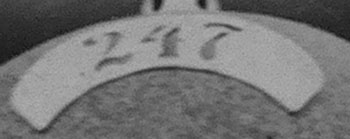
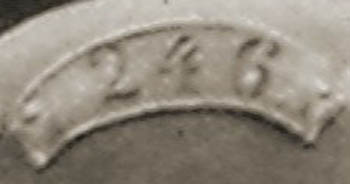
2.
This type is commonly seen in surviving artifacts and examples. It
consists of a metal plate with embossed numbers. The helmet plate is
secured through the use of split brad retainers. We will refer to
this as type 2.

3.
This type is commonly seen in references and unfortunately has been the
subject of reproduction. It consists of unit number below the letter
"R". The numbers are either cut out or embossed. We will refer to
this as type 3
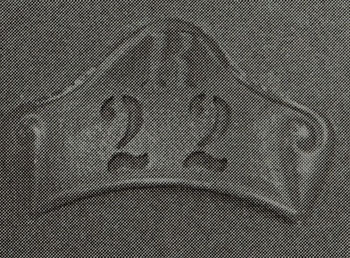
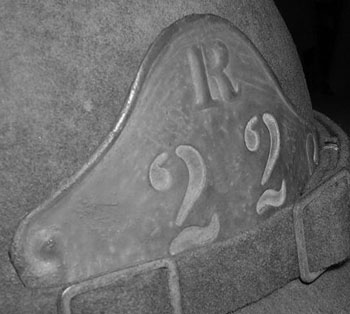
The
helmets are generally made of an Ersatz substitute material. Most
of them are made out of filz. However they have been documented
with cork covered with cloth. They were worn with an M15 type bayonet
spike base that is ventilated. There is a ventilation cover on the rear
spine. There are M 91 posts made of gray metal. They are
found both with and without a visor trim and the chin straps are made
of leather.
That helmets were often worn with a long neck
covering. This is known by several names but we will call it
"Nackenschutz". The Nackenschutz was a separate item and attaches to
head gear through a separate band and buckle. Lacarde makes reference
to the band being elastic. The Nackenschutz did not need to be worn
with a helmet.
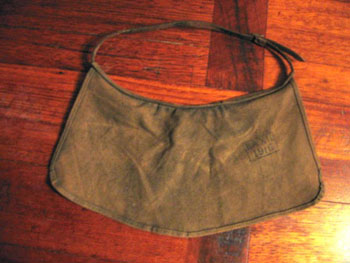 iii
iii
Johansson
has an example of a type 3 in his book "Pickelhauben" on page 60.
It is a filz helmet with a ventilated spike base and a scroll with cut
out letters. He calls the metal "pewter", and states that the R22
designation stands for Infantry Regiment 22. There is no visor
trim. It has a black leather chinstrap with gray metal
buckles. On page 61, he shows a type 2 used on a cork
helmet with a white cloth covering. This appears to say 116. It
has a brown leather chinstrap with no buckles. iv
Lacarde in volume 1 page 112 shows a type 1A with a number 212, a visor
trim and two gray buckles. He mentions steel fittings. v (This helmet is from Fort de la Pompelle and a shown later in the article)
Kraus in his book "The German Army" shows an example on page 70 that is
a type 2, with the number 135. The helmet is clearly marked to
Bekleidungsamt XVI. Kraus goes on to admit that this helmet is of
unknown origin. It has a leather visor trim, a black chinstrap and
cockards. On page 71 he has a helmet that does not have the
scroll but has a unit number painted directly onto the front of the
helmet. This helmet also has a Nackenschutz and is clearly marked
to the 205th Pioneer Company. vi
The Belgian Army Museum has a similar helmet shown here in a picture
taken by Max Chaffotte. So far I have been unable to determine the
source of this helmet.
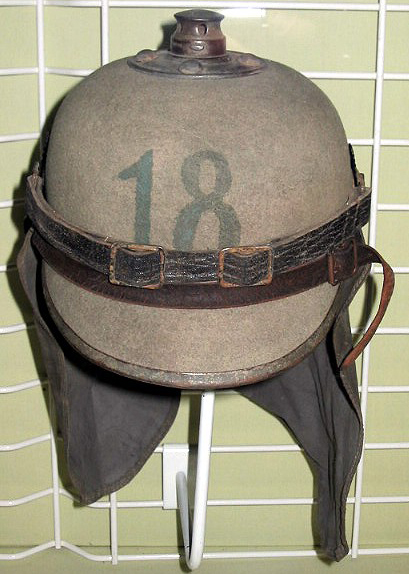
In the Wurrtemberg book -- Konigreich Wurtemburg die Militärische Kopfbedeckungen
-- on page 56 there is a picture of a soldier wearing a type 1 with a
Nackenschutz but no visor trim. The picture is attributed to Gebirgs
Maschinengewehr Abteilung 250, this is a Wurrtemberg formation created
7 September 1915. vii
On page 87 of the two-volume book by Kraus there are a series of
diagrams. These include a type 3 R116, a type 2 227,
a type 3 R22, and a type 2 that looks to be 237. viii
Where
References are full of two different locations for these helmets. Serbia and Macedonia.
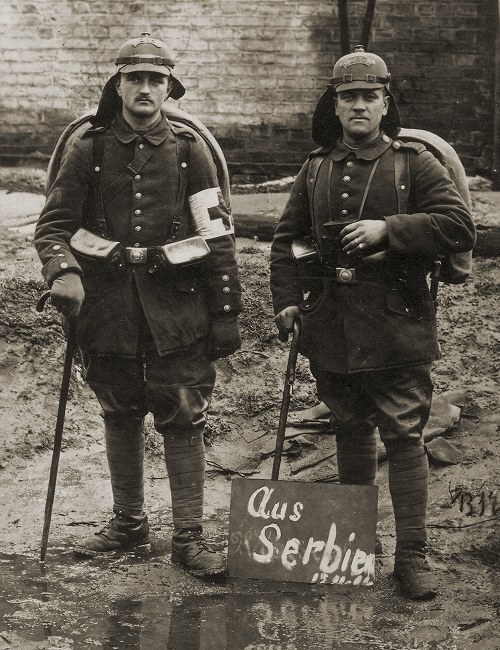
Both
of these are illustrated on this map. Everyone knows where Serbia
is however this was the fourth invasion of Serbia in 1915.
Macedonia is a different concept. You can see Macedonia on the
very southern border of Serbia. What exactly is Macedonia is
still debated. Bulgaria, Serbia and Greece all had land claims to
parts of Macedonia. Each country's different interpretation of
what Macedonia was continues to this day. A small bit of trivia
is that the modern country of Macedonia is actually known as
FYROM. That abbreviation stands for the Former Yugoslavian
Republic of Macedonia. That name was finally settled on after vehement
disputes over who owned Macedonia between Bulgaria, Greece and the new
country.
For our purposes, Macedonia is the front between the Central Power Armies and the Entente armies headquartered in Salonika.
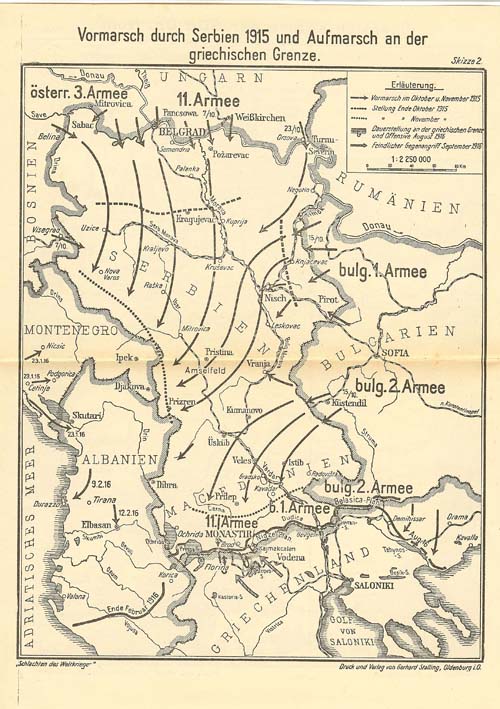 ix
ix
When
This
can be a very sticky question. The original Prussian order from
the War Minister was dated to August 1915. The invasion of Serbia
that these troops allegedly were involved in started in October of
1915. The very first picture on this page is dated November 1915. The
manning of the Macedonian frontier continued until the end of the war.
It is unclear when helmets were no longer worn on the Macedonian
front. Below is a picture of Gebirgs Maschinengewehr Abteilung
249 in Macedonia dated 11/7/1916 wearing a tropical helmet. The
gentleman on the right wrote a series of postcards from April 1917.
Pictures from Palestine show tropical helmets without scrolls still
being worn in 1918. The Prussian War Minister decreed that there would
be no more use of filz helmets on the front after August 15, 1917. Did
this include Macedonia?
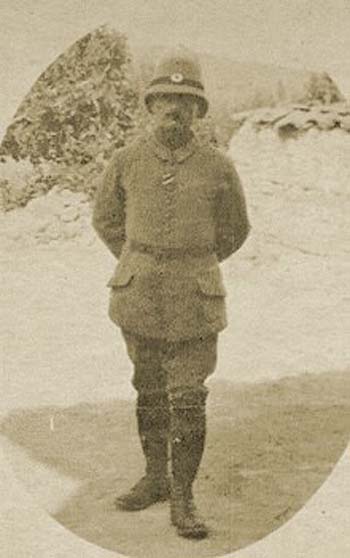
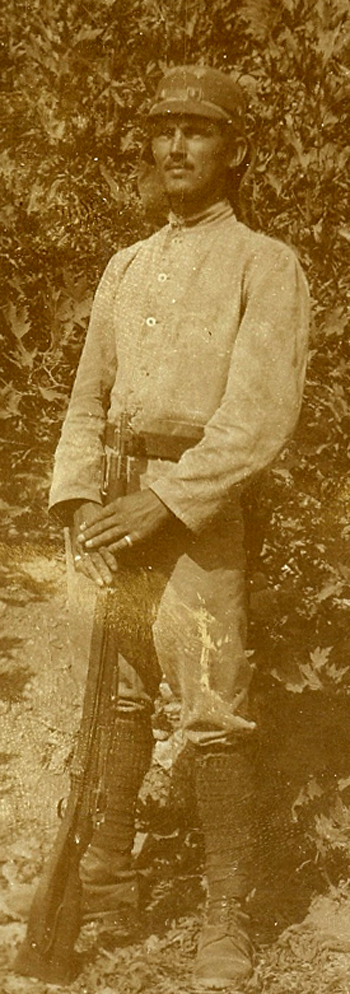 collecton Hinsely
collecton Hinsely 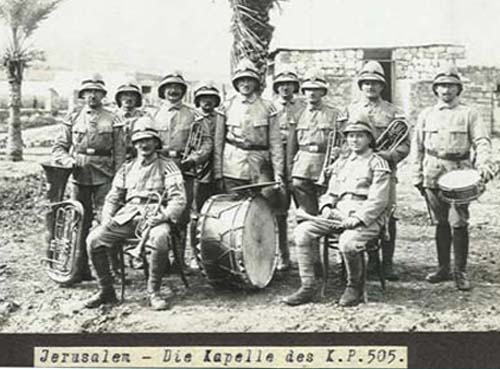
This is the depot in Alexinac that was established for these units. The writer confirms the location, although misspelled. The depot was opened around May 7th, 1917. It comprised personnel for training, medical care etc.
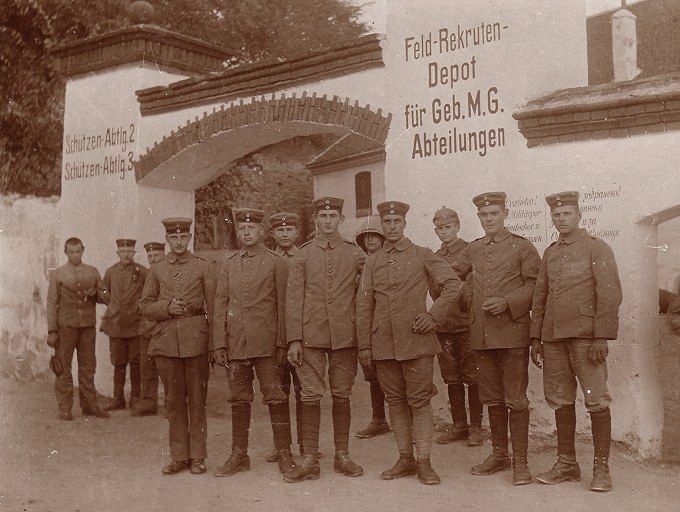
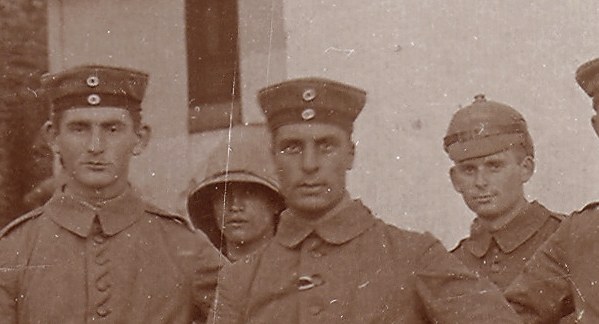
Not much detail there. However, the guy with the big helmet poses another question. Did these units switch helmets?
Who
Gebirgs Maschinengewehr Abteilung
The
original Prussian order from the War Minister established scroll
helmets for the Gebirgs Maschinengewehr Abteilung 211 through 250.
There are several pictures of these mountain machine gun battalions.
They were not assigned to divisions and are somewhat difficult to
track. All of the pictures of the Gebirgs Maschinengewehr Abteilung
have a type 1 and 2 helmet Wappen. While there are questions of timing
there is no question really about these machine gun units having a
scroll helmet. There is documentation that says that GMGA 211 thru 250
had numbered shields. There is an example of a helmet with a type
1A plate for 212. There are diagrams in references for a type two 227,
and 237 and a picture of a soldier wearing a 218, 228, 232, 238, 246, 247 and a
250 type one. The entire empire contributed to these.
Württemberg: GMGA 250
Saxony: GMGA 249
Bavaria: GMGAs 206-209 (later GMGA 262), and 248
Prussia: GMGAs 201-205, 210-247, 251-255 (in 1918, 15 of these these bacame the new units 260, 261 and 263-265)
Order
of battle information on these machine gun units is very hard to come
by and must be pieced together. There are no unit histories for these
units. GMGA 201 through 209 were formed primarily of
cavalry division's on the Western front.GMGA 210 and 251 also seem to
have been assigned to Belgium on the Western front. It appears as
though GMGA number 242, 244, 245 and 246 were attached to the sixth
infantry division in 1917 and transferred out of Macedonia. There is a
picture of GMGA 203 in Macedonia in Dec. 1916.
Another
researcher by the name of Robert Hinsley has extensively dug into these
GMGA. The following paragraphs and conclusion is a quote from Robert
that was placed on pickelhaubes.com.
In
the following I will translate what is written about the GMGA formation
until 1917, leaving out some lenghty passages (marked ...) and marking
my own notes with square brackets. The orders are usually referenced
via footnotes:
"Very
soon after war begin the need for special machinegun units besides the
regular MG issues for the troops fighting in mountain terrain became
obvious in the Vosges and the eastern front. Only whith these it was
possible to move firepower quickly to the required places, to support
own actions or defend stretched frontlines against superior enemy
forces. Upon an urgend request of the OHL [Oberste Heeresleitung, i.e.
highest army command], fourty GMGAs numbered 211 to 250 were quickly
assembled by the MG training course Döberitz beginning in August
1915. 18 of these units had to be deployable by Sept. 9th, the
following 22 by Sept. 20th 1915 (Pr. Kr. Min. Nr. 2002/8. 15 A. 2 D
from August 21st, 1915). The mobilization of these troop was so
important that all other requests had to stand back and the outfitting
of other MG units that were planned for August and September was
delayed. All personnel and carriage animals that had been sent to
Döberitz for other reasons were assigned to the first 18 GMGA units
(Pr. Kr. Min. Nr. 976/8. 15 A. 2 D from August 12th, 1915). The
following 22 GMGA units were equipped with personnel and horses by the
Stellv. Gen. Kos. [assistant general commands?] by Sept. 7th 1915, with
Württemberg providing one of these units. The personnel had to be of
good health and suitable for action in mountain terrain. The special
mountain equipment and the uniforms were provided by the Pr. Kr. Min.
(Prussian war ministery), guns, harnesses and ammunition by the Gew.
Prüf. Kom. [Gewehr Prüf-Kommission, i.e. an arms inspection commision?]
resp. the field maintenance depot. The mountain MG personnel received
the gray-green uniform of the machinegun units with the units numbers
on the shoulder flaps, and experimentally a lighweight helmet of felt
with matte fittings, ventilation and a neck flap (Pr. Kr. Min. Nr.
1960/11. 15 B. 3 D). The GMGA units were organized in 2 platoons with 3
machineguns each and had a required strength of 4 officers, 175 other
ranks, 85 horses (including 48 carriage animals) and 7 vehicles.
Upon
this order the personnel for the Württemberg GMGA 250 was assembled at
the 1. Ersatz machinegun company 121 in Münsingen and send to the MG
training in Döberitz on Sept. 5th. By Sept. 15th the unit was regarded
to be mobile and already 14 days later on Oct. 1st it was deployed to
the 11. army in order to move to the Oberkommando Mackensen from
southern Hungary and participate in the offensive against Serbia.
This
way fourty GMGA units were mobilized in a single month. ... Upon orders
of the OHL, the GMGA units 235-238, 241 and 243-246 were reorganized to
MG companies in March 1916 and attached to infantry regiments as first
or second MG companies (Pr. Kr. Min. Nr. 1656/2. 16 A. 2 D). At the
same time, the remaining GMGAs were strenghtened by 21 men, 20 horses
and 3 double-sided vehicles [wagons with two horses] each, the latter
being light Gebirgswagen 15 or vehicles of the region. ... While
this increase of strength became effective, orders of the ADK 11 (army
group Mackensen) attached the GMGA units 210, 240 and 247-250 to the
5th Bulgarian division were they served at a streched frontline. This
deployment required to increase the number of machineguns from 6 to 9
by the end of July 1916. This state remained until early 1917. On May
7th 1917 a verification of the strength of all GMGAs was again required
and confirmed at 9 guns per unit. At the same time, a depot with the
name "Feldrekrutendepot für G.-M.G.-Abtlgen der Heeresgruppe Scholtz"
was established in Alexinac for the GMGA units in Serbia (*).
* Footnote:
Consisting of command, training personnel, rifleman detachment,
carriage animal unit, surgical unit. Total strength: 16 officers, 827
men, 127 horses (including 90 carriage animals) and 7 vehicles. ...
After
this reorganization the required strength of a GMGA was 9 machineguns,
4 officers, 247 other ranks, 139 horses (including 80 carriage animals)
and 21 vehicles, allthough this strength was never reached due to the
increasing shortage of personnel and equipment."
...
Some conclusions:
*
The reason that often only the GMGA units 211-250 are mentioned may be
that these were the first batch that was mobilized. Evidently, the
lower numbers 201-210 followed later.
*
The uniforms were provided by Prussia, which is probably the reason why
GMGAs from different states have identical outfit (including helmets).
* The special helmet model was intentional and not (or at least not exclusively) the result of the shortage.
*
The GMGAs have a quite large number of horses and carriage animals
(139/80 after beefing up in 1917) considering their size similar to
companies. In other parts of the document it is described how difficult
it was to equip the mountain units with suitable carriage animals.
Carriage ponys were even imported from Sweden. So evidently the
mobility (and independence from other transport units) was regarded a
main asset of a GMGA.
However, none of these listings can come close to explaining this picture. While there is nothing on the back it seems to show the number 270. There was no 270 according to these listings. Are the listings in error? Is it not 270? Look at the shoulder strap–what is that?
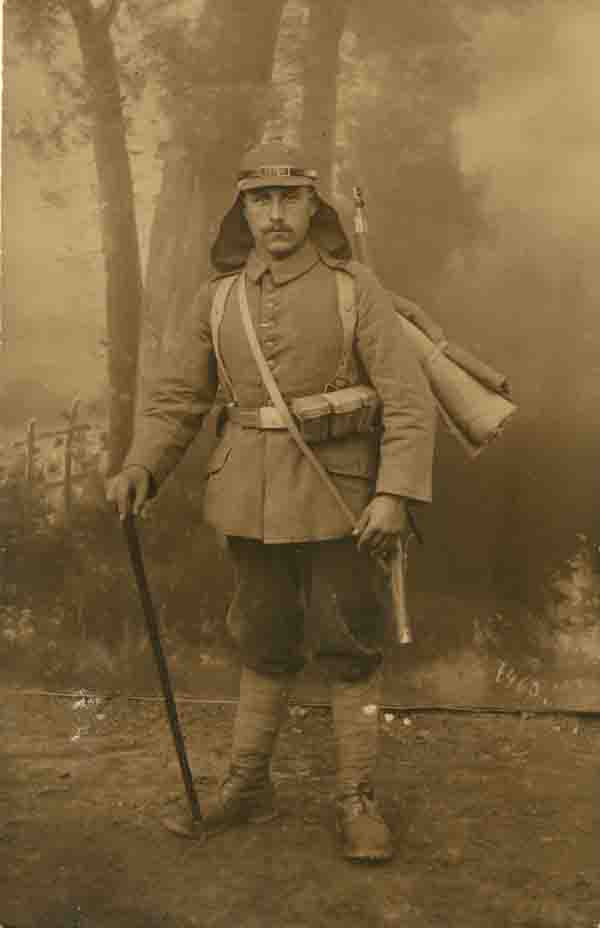
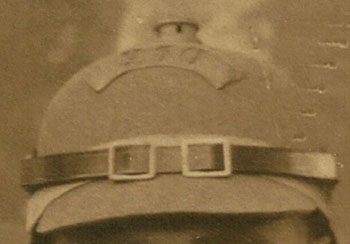
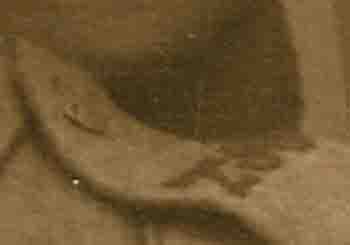
Here are some additional pictures of scroll helmets.
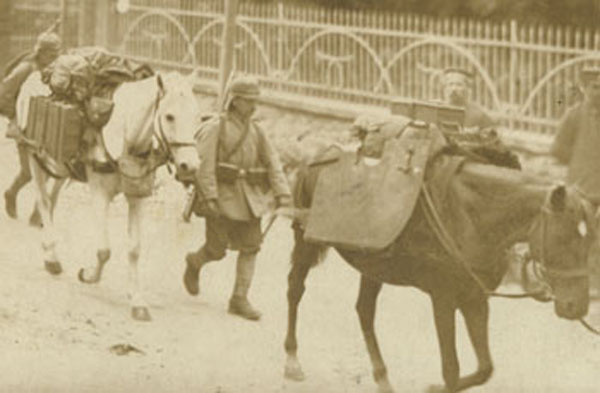
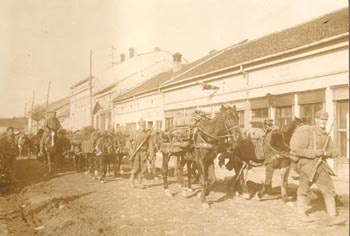
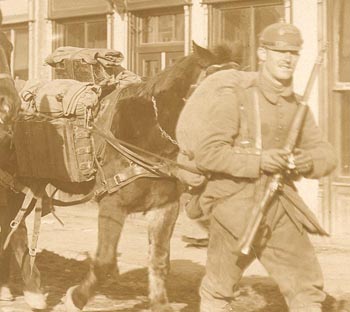
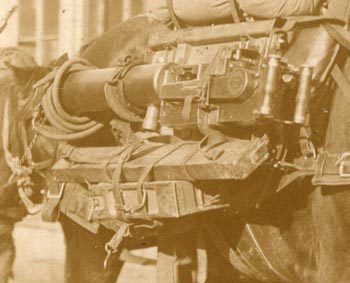
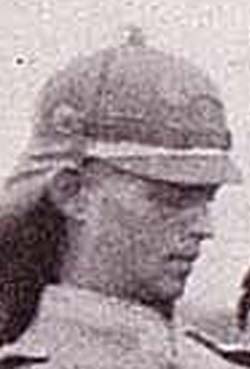
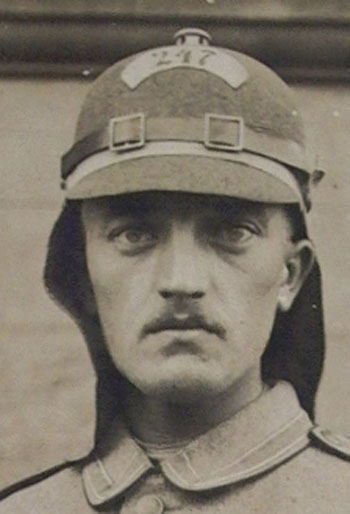
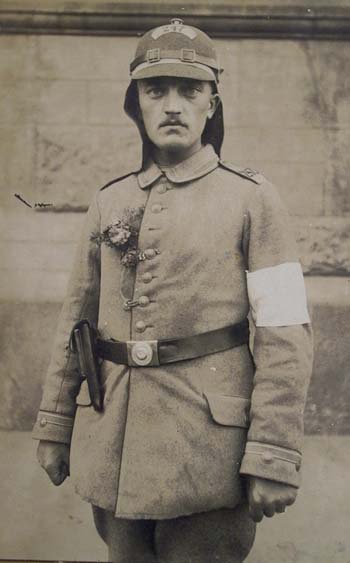
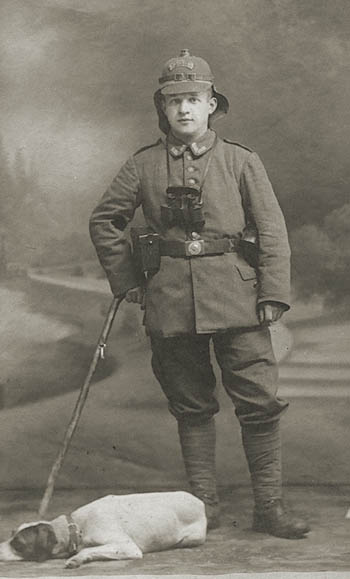
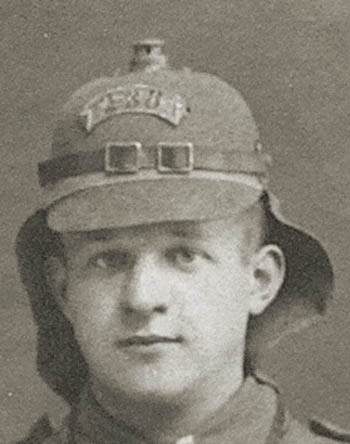
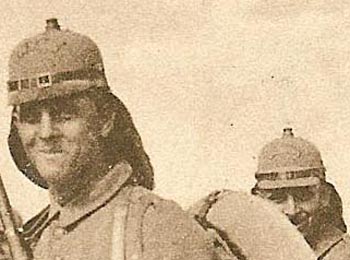

Variations and Holes
Some
of these pictures with type 1 helmet scrolls show a hole on the
left-hand side of the scroll. It is believed that these are production
holes made by the manufacturer to accommodate another type of Wappen on
these helmets. There seems to be a convention where if there was an
extra space it would be placed in the same area. It is not clear what
kind of Wappen was originally designed for these filz helmets.

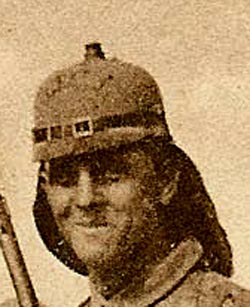
In
addition, there is a variation between the plate for 238, 246 and the one
for 247. There seems to be an edge design on the 238 scroll.
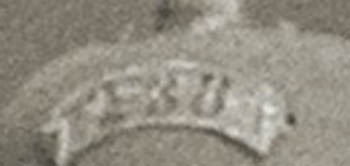


Both
the hole and the edge design can be seen in this picture from Fort de
la Pompelle. The picture of this helmet was provided by Max Chaffotte.
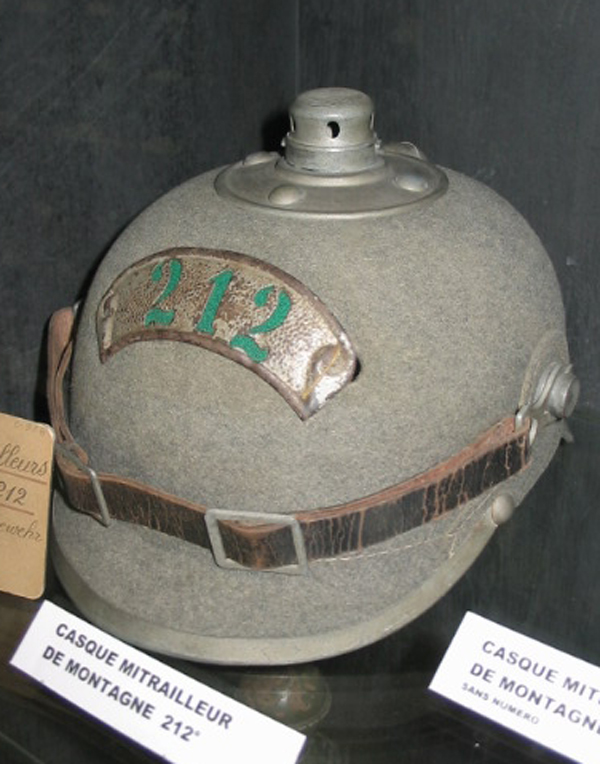
The hole is on both sides in this picture and appears plugged.
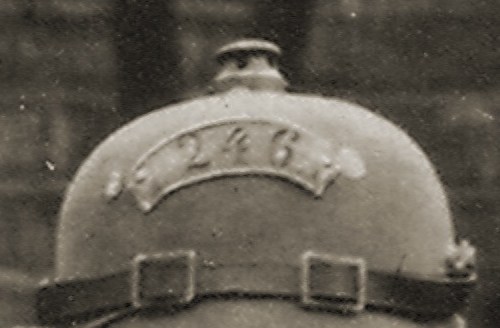
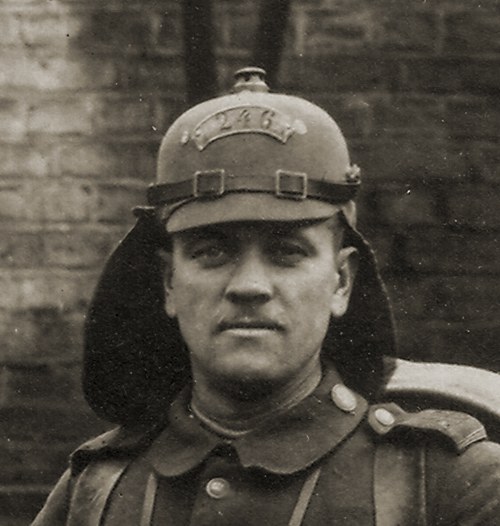
This picture has both a helmet and a shako from GMGA 247.
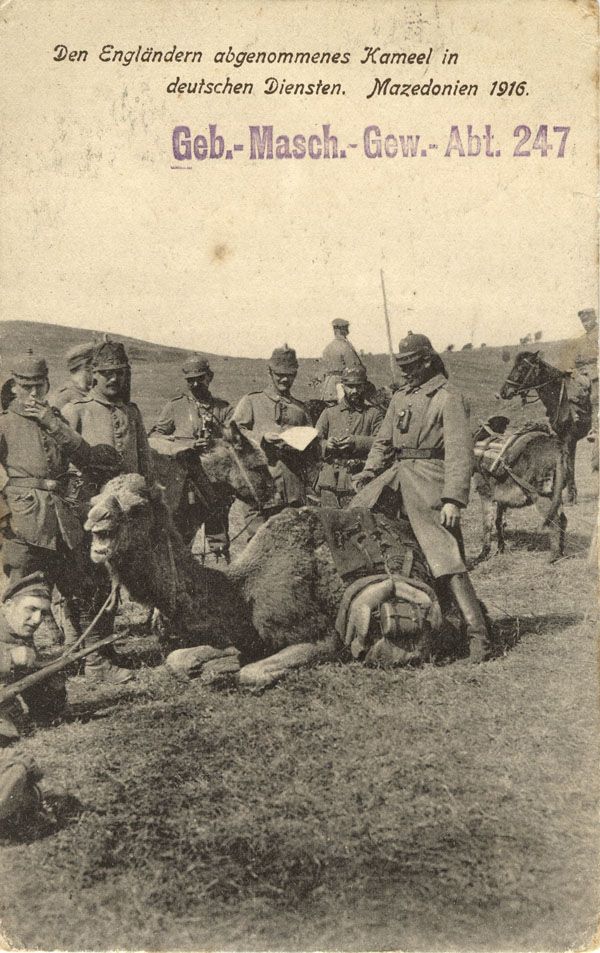
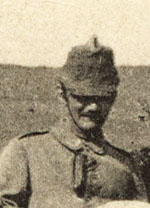
11th Army- Gen der Artillerie von Gallwitz- Regiments
The
order of Battle of the 11th Army, which went into Serbia varies a lot
depending upon the reference. I don't mean a little bit -- I mean
it really varies both corps and division assignments. According to the
Histories of the 251 Divisions there are actually two Reserve Infantry
Regiment 116 in two different divisions! Having looked and discussed
this with other researchers this is my best attempt at an order of
battle as of 4 October 1915.
III Corps. - Gen der Infanterie von Lochow
for
6th Division.
20th Regiment.
24th Regiment.
64th Regiment
25th Reserve Division.
118th Reserve Regiment.
83rd Reserve Regiment.
168th Regiment
IV Reserve Corps - Genlt von Winckler
105th Division.
21st Regiment.
122nd Fusilier Regiment.
129th Regiment
107th Division.
52nd Reserve Regiment.
227th Reserve Regiment.
232nd Reserve Regiment
11th Bavarian Division.
3rd Bavarian Regiment.
22nd Bavarian Regiment.
13th Bavarian Reserve Regiment
X Reserve Corps.- Genlt Kosch
101st Division.
45th Regiment.
59th Regiment.
146 Regiment
103rd Division
32nd Regiment.
71st Regiment.
116th Reserve Regiment
XXII Reserve Corps. Operating in Serbia under the Third Austrian Army
43rd Reserve Division.
201st Reserve Regiment.
202nd Reserve Regiment.
203rd Reserve Regiment
204th Reserve Regiment.
15th Reserve Jäger Battalion
44th Reserve Division.
205th Reserve Regiment.
206th Reserve Regiment.
207th Reserve Regiment
208th Reserve Regiment.
26th Division.
119th Gren. Regiment.
125th Regiment.
121st Regiment
122 Fusilier Regiment.
AlpenKorps Division
Of
these regiments. There is a diagram of a type 3 R116. This
would make immense sense for the 116th Reserve Regiment of the 103rd
Infantry Division. The example shown in Kraus of the 205th
Pioneer Company with a Nackenshutz but no Wappen at all and the numbers
painted on the helmet was assigned to the 103rd Infantry Division
during the Serbian campaign. In addition there is this picture of
the 122nd Fusilier Regiment.
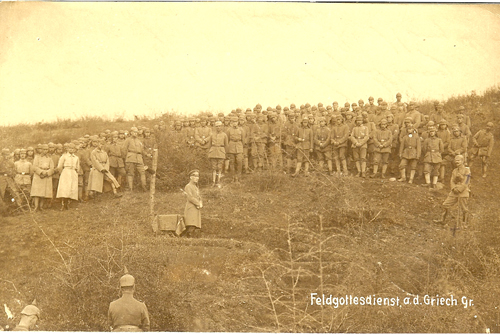
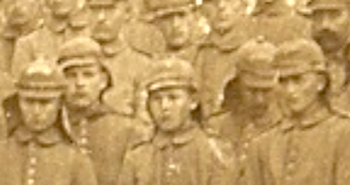
This
picture shows a religious celebration on the Greek border. The
card is legible on the back where it was sent from East Galatia on the
26th of June 1916. The 122nd Fusilier Regiment did indeed push on
to southern Serbia. In June of 1916 the Regiment was sent to
Galatia in response to the June Russian offensive. x
In that operation, the Regiment was severely decimated. Therefore
this picture seems to be taken in Macedonia just before the Regiment
left for Galatia. You notice the type 1 helmet Wappen, the
Nackenschutz, and the lack of an Uberzug or helmet cover. The
mass of enlisted soldiers was accompanied by their officers at this
religious service.
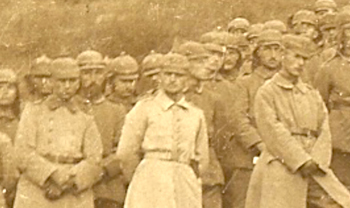
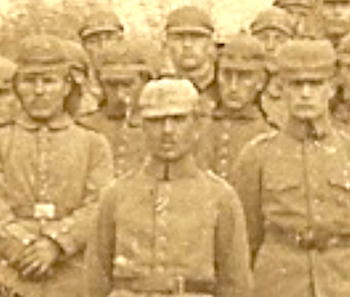
The officers and top NCO wore a spiked helmet with an Uberzug but no Nackenshutz in the picture.
This
was the first picture of an officer found wearing a scroll helmet. It
is not clear what unit he comes from. There is yet another picture of
an officer with the scroll helmet and a Nackenschutz where the helmet
has a spike.
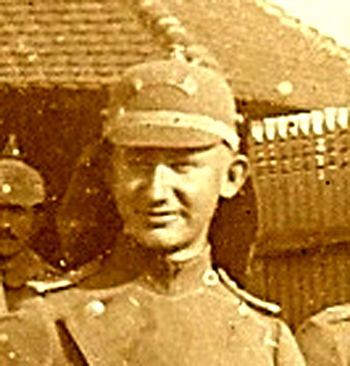
Other Helmets
Here
is another example from the collection at Fort de la Pompelle taken by
Max Chaffotte. The museum attributes this helmet to the "Würrtemberg
mountain train" 4th mule-mounted company of the 101st mountain
division. 1916. While this division spent almost all its time in
Macedonia it was not a Württemberg division however it is noted
according to the 251 Divisions as having had four Württemberg pack
trains in 1918. There is no mention of this helmet in the Württemberg
book and the cockade on the left side of the helmet appears to be a
Reich's cockade. You will also notice that there is no Nackenschutz on
this helmet.
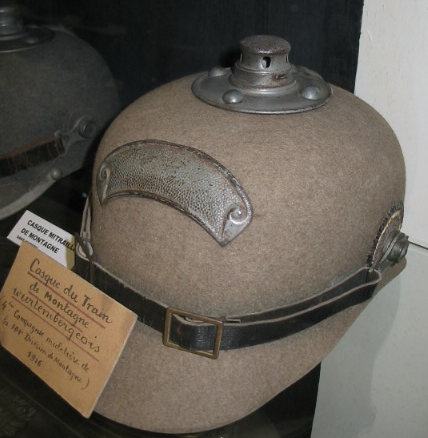
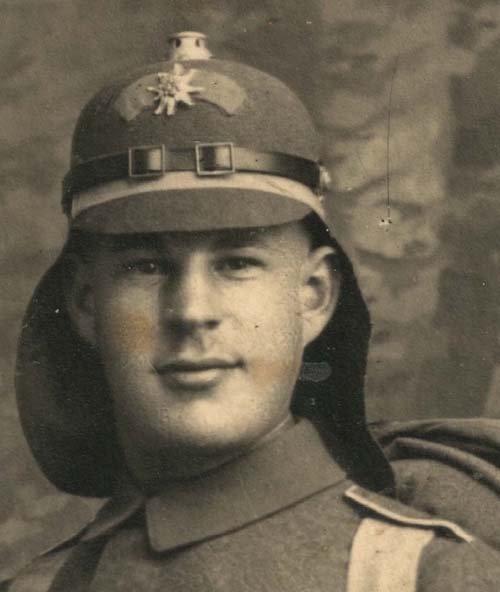
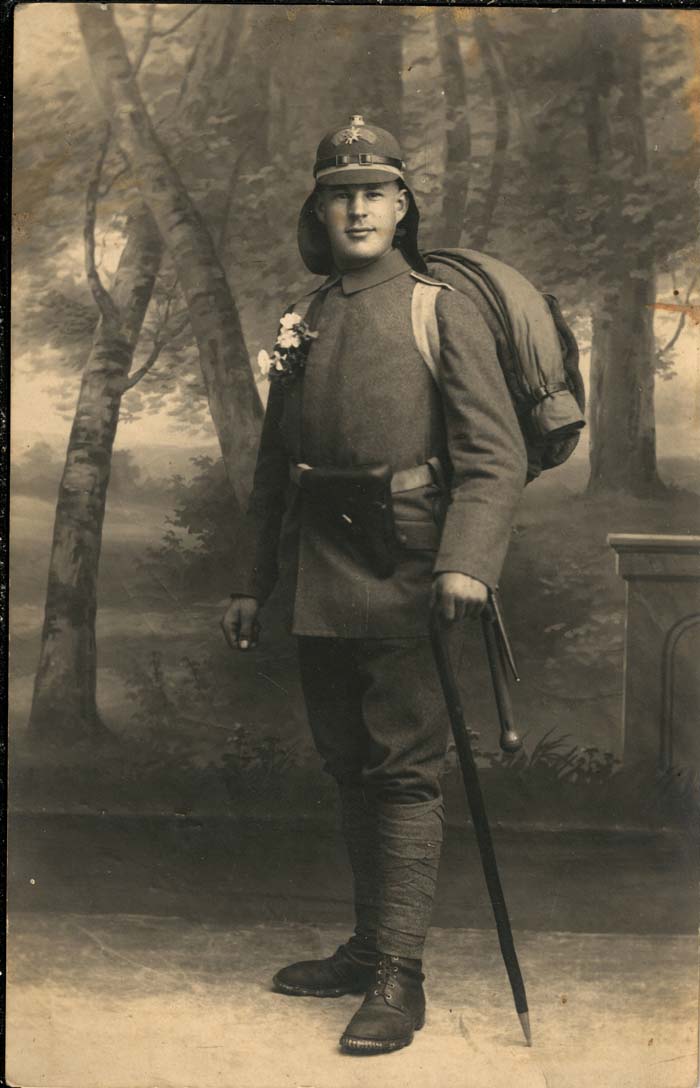
Something is wrong with conventional wisdom
As
these helmets continue to be looked at through the lens of Serbia and
Macedonia, cracks begin to emerge in the theory. Contrary to previous
thought these helmets appear in France.
Given
11th Army order of battle the famous R22 helmet makes no
sense. Reserve Infantry Regiment 22 spent its time in the
12th Reserve Division in France until August 1915 then was transferred
to the 117th Infantry Division. In August of 1916 the 117th
Infantry Division left France -- the Somme -- and went to Romania; the
Carpathian Mountains which are nowhere near Serbia or Macedonia.
There is a diagram of a type 3 R116 and an example of a type 2 Wappen
that says 116. While Reserve Regiment 116 makes sense -- active
Regiment 116 does not. Infantry Regiment 116 spent the entire war
with the 25th Infantry Division. The entire war was spent in
France. 1915 and 1916 were on the Somme and Verdun. Certainly
this was far away from a white colored cloth covered cork helmet with a
Nackenschutz.
The helmet that
Kraus shows with the type 2 -- 135 Bekleidungsamt Mark XVI rather then
being of unknown origin, sure looks like it would be from 3.
Lothringisches Infanterie-Regiment Nr.135 of the XVI Corps. Infantry
Regiment 135 spent the entire war with the 33rd Infantry Division. The
division never left France and from September 1914 to August of 1916 it
was in the Argonne. xi There is no Nackenschutz on the Kraus helmet.
The initial compelling argument about scroll helmets in France comes from this picture.
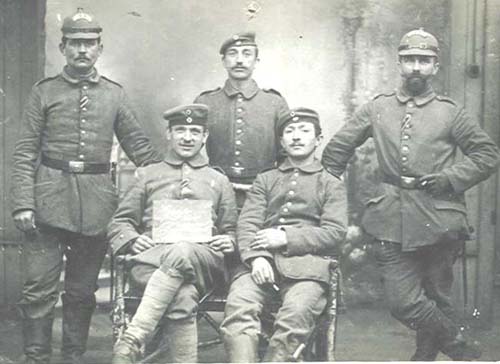


These
two soldiers are from Infantry Regiment 51. They do not have a
Nackenschutz. The back of the card while not mailed is very legible and
says
The best greetings is sending you Michael.
I am well healthy and agile yet; send
in attachment a photograph for
memory to the
conquerors of Frise at the Somme.
The
Battle of Frise was a significant accomplishment for the Germans in
January 1916. These individuals were obviously very proud of their
accomplishment as part of this effort. Looking at the picture sometimes
it's difficult to determine if this is a 51 or 31. It is Koeniglich 4.
Niederschlesischen Infanterie Regiment Nr. 51 The translation confirms
it. No other infantry unit in 11th Infantry Division (and there is no
doubt that the 11th Infantry Division were the ones who 'stormed'
Frise) could be mistaken for it. The other numbers involved were 10, 11
& 38. Even if it had been IR 31, it would still not support the
Serbia theory, because that regiment was part of 18th Infantry Division
which spent a large part of the war in various parts of France until
early July 1916 when it arrived on the Somme in Champagne.
While the picture above shows the potential of scroll helmets being used by units that never went to Macedonia this picture below provides proof positive that units that had been in Macedonia wearing a scroll helmet returned in some cases to the Western front with those helmets. This postcard from the collection of Hans Dieter Zimmer was written in Vogesen 12.1.16. That is in Alsace-Lorraine. According to a translation kindly provided by Immanuel:
Feldpost
An Familie Friedrich Walter
Saarbücken 6
Saargmünderstr. 64
Vogesen 12.1.16
Will Euch meine Lieben auch mal wieder eine Kriegserinnerung geben in unserer alten Uniform. Wir bekommen aber jedenfalls bald wieder andere. Die Pfeife von Heinrich freut mich täglich mehr und raucht sich sehr gut. Hoffe auch wenn das große Paket Tabak alle ist wird auch der Krieg zu Ende sein. Ich grüße Euch alle herzlich Euer Wilhelm.
I just want to send you another war memory in our old uniform. Soon we are going to get some others. The pipe from Heinrich pleases me more and more from day to day and it smokes very well. I hope that the war is over when I finished the big pack of tabacco. Best regards to you all from your Wilhelm
An analysis of this was produced by Xiphophilos:
Wilhelm, the author of the postcard, says that he and his friend are depicted in their old uniform, and he expects that they'll soon get different uniforms. So I wonder if this uniform was originally distributed to the writer's unit when they were in a place like Macedonia, even though they were at the time the postcard was written in the Vosges Mountains and still wearing the same uniform.
This unit GMGA 227 was part of the great 12th Landwehr division which had some horrible experiences and losses at the Hartmannswillerkopf in late December 1915.
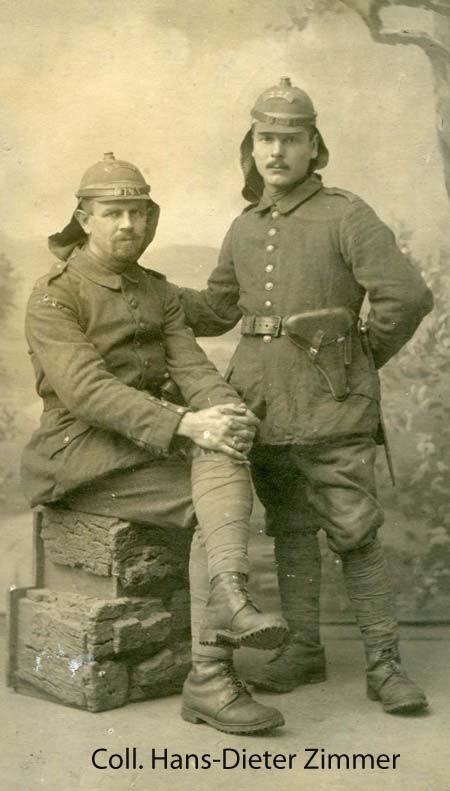
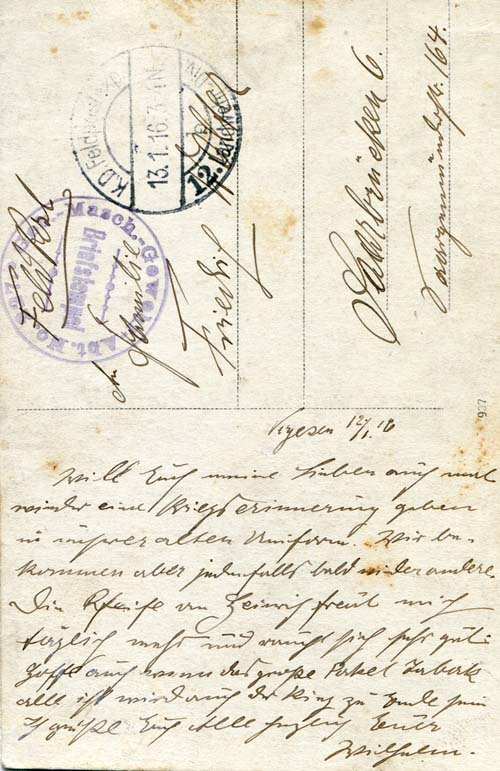
Then there is this, both the scroll and the helmet cover say 23. Infantry Regiment 23 was part of the 12th Infantry Division and never left France until Dec. 1916.
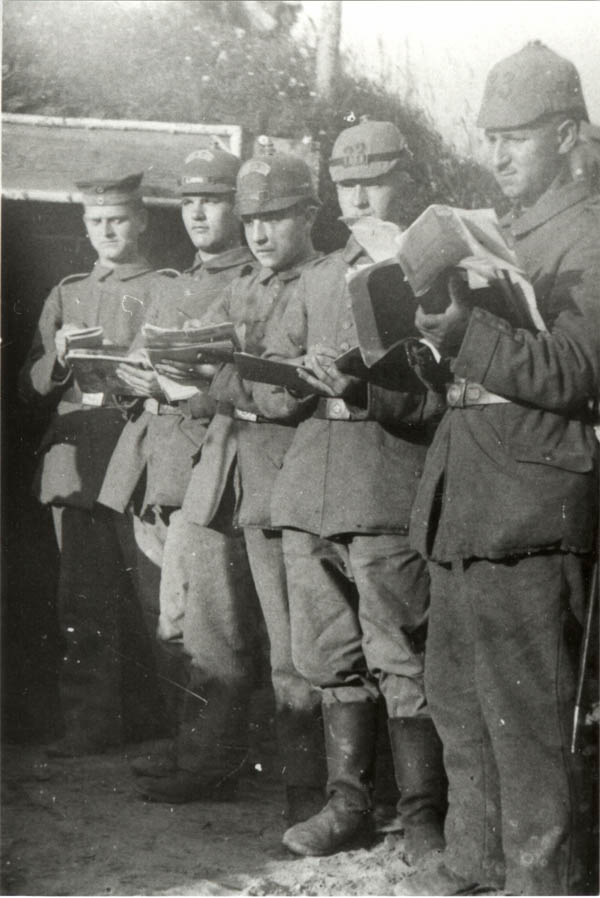
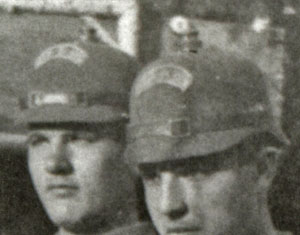
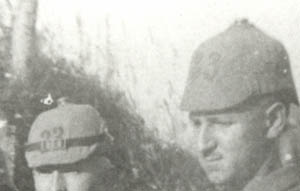
This incredibly nice picture from the collection of Sam Wouters poses more proof and questions. There is a sender's address on the back that is totally clear. GMGA 218 which was part of the Bavarian 6th Landwehr Division. Based on the number this would be a Prussian unit in a Bavarian Division. It is dated June 16, 1916 from the Vogesen region of the Western Front. Notice that the clear Edelweiss badge on their collar. It looks different from the type worn by the Alpenkorps. Perhaps it is an unofficial variant worn by some mountain units such as this one? Or maybe a real flower?
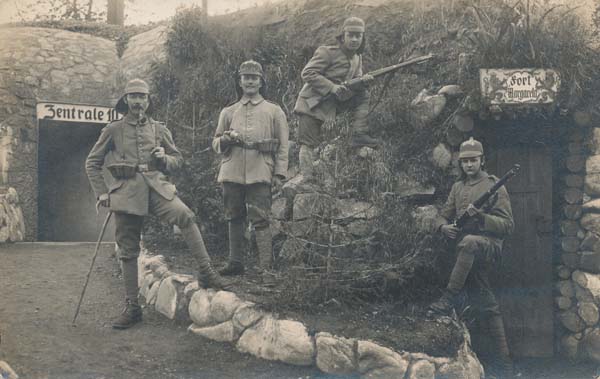
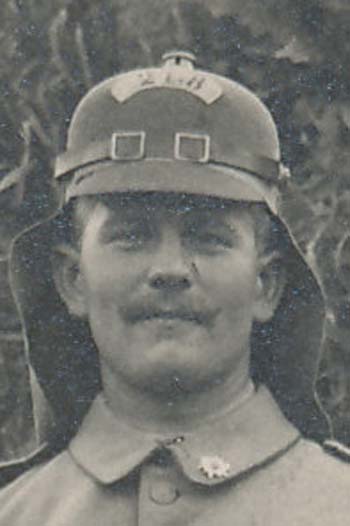
What Does It All Mean?
Precious
little! I was once accused of being an obscurantist by a
distinguished colleague. Conventional wisdom which had dismissed these
helmets as a Serbian anomaly paid it far little thought. Based on
expediencies and production these helmets were used in various
locations. For instance I'm sure that the 122nd Fusilier Regiment did
not exchange helmets upon their emergency redeployment to face the
Russians in East Galatia. It also shows that there were several
different variations on the theme and that this might help in
identifying some helmets that are more legitimate. I would like to
formally thank Robert Hinesley who kindly lent me a picture that got me
going to finish this. He deserves more credit than you think.
Back to the Beginning
This all started out as a search for Reserve Infantry Regiment 22.
Clearly this was a unit that served in France and unfortunately has
been the subject of many reproductions. My understanding is that
there were two waves of reproductions. One came from the old
Czechoslovakia and was easily spotted as the filz was "squishy" instead
of very stiff. The second wave came from Great Britain and could most
easily be spotted by a brown leather like trim around the helmet. The
example in the Johansson book is a type 3 with cut out letters. Most of
the reproductions seem to have embossed letters. Here is an
example that has the telltale marks of a reproduction unfortunately.
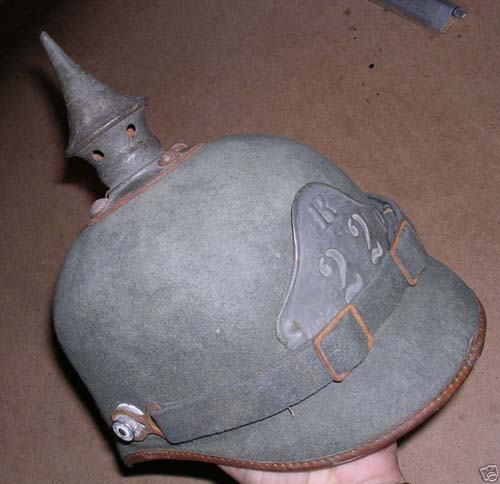 xii
xii
There
is a spike, and the telltale brown leather like trim. In addition
there is a maker's mark and a mark from the Bekleidungsamt IX Corps.
This too appears faked as simple research would show that Reserve
Infantry Regiment 22 was in VI Corps.
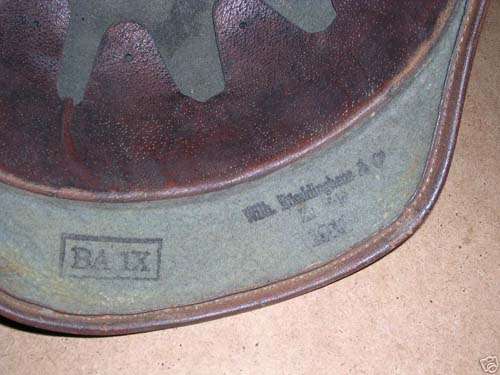 xiii
xiii
I wish I had better news about this helmet but I do not.
Please if you have any other pictures or examples that I can use I would be glad to include them in the analysis.
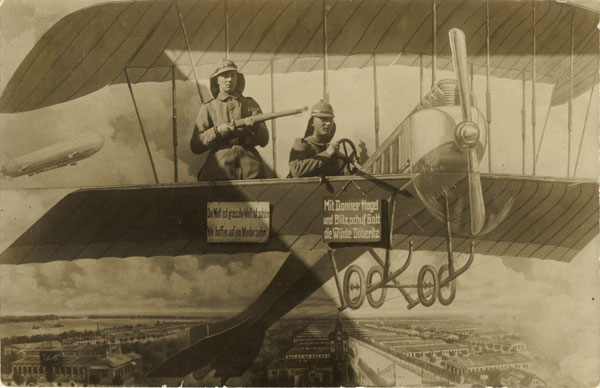
i With permission from the collection of Robert Hinsley
ii Kraus, Jürgen, Die feldgraue Uniformierung des deutschen Heere , Biblio Verlag, Osnabrook, 1999. (German) pg.88.
iii Johansson, Eric, Pickelhauben,, H.S.M. Publications, Independence MO, 1982 (English)
iv Lacarde, Jean Louis, Vol.1 and Vol. 2, Jacques Grancher, Paris, 1983
v Kraus Jürgen, The German Army, Verlag Militaria , Austria , 2004 (English) pg.70-71.
vi Wannenwetsch & Hilsenbeck , Konigreich Wurtemburg die Militärische Kopfbedeckungen 1869-1919 , Steinach-Verlag,Reutlingen 11 , 1993 (German)
vii Kraus, Jürgen, Die feldgraue Uniformierung des deutschen Heere two volumes, Biblio Verlag, Osnabrook, 1999. (German)
viiiix Schlachten des Weltkriegs, Reichsarchive band 5.
x Histories of the 251 Divisions of the German Army, pg 590.
xi Histories of the 251 Divisions of the German Army
All pictures from GMGA 238 and 247 from the Robert Hinsley Collection.